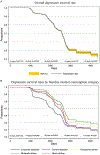Alcohol consumption predicts incidence of depressive episodes across 10 years among older adults in 19 countries
- PMID: 31733662
- PMCID: PMC7362478
- DOI: 10.1016/bs.irn.2019.09.001
Alcohol consumption predicts incidence of depressive episodes across 10 years among older adults in 19 countries
Abstract
Alcohol consumption is increasing in many countries, and excessive alcohol consumption is particularly increasing among older adults. Excessive alcohol consumption causes morbidity and mortality, especially among older adults, including an increased risk of depressive episodes. We review the mechanisms through which alcohol consumption may affect depression, and argue that the effects of alcohol consumption on depressive episodes among older adults are understudied. We harmonized data among older adults (≥50 years) on alcohol consumption, depressive episodes, and an array of risk factors across 10 years and 19 countries (N=57,276). Alcohol consumption was categorized as current or long-term abstainer, occasional, moderate and heavy drinking at an average of 2.3 follow-up time points. Depressive episodes were measured through the CES-D or EURO-D. Multi-level Cox proportional frailty models in which the random effect has a multiplicative relationship to hazard were estimated with controls for co-occurring medical conditions, health behaviors, and demographics. Long-term alcohol abstainers had a higher hazard of depressive episodes (HR=1.14, 95% C.I. 1.08-1.21), as did those reporting occasional (HR=1.16, 95% C.I. 1.10-1.21) and heavy drinking (HR=1.22, 95% C.I. 1.13-1.30), compared with moderate drinking. Hazard ratios were attenuated in frailty models; heavy drinking, however, remained robustly associated in a random-effects model with a frailty component (HR=1.16, 95% C.I. 1.11-1.21). Interactions were observed by gender and smoking status: long-term abstainers, women's, and smokers' (HR for interaction, 1.04, 95% C.I. 1.00-1.07) hazards of depressive episodes increased more than what would be expected based on their multiplicative effects, when compared to moderate drinking, non-smoking men. Excessive alcohol consumption among older adults is a concern not only for physical, but also for mental health. Physician efforts to screen older adults for excessive alcohol use is critical for mental health to remain strong in aging populations.
Keywords: Aging; Alcohol; Binge drinking; Cross-country; Depression; Harmonization; Mental health.
© 2019 Elsevier Inc. All rights reserved.
Conflict of interest statement
Conflict of interest
The authors report no conflicts of interest.
Figures




Similar articles
-
Relationship of Alcohol Consumption to All-Cause, Cardiovascular, and Cancer-Related Mortality in U.S. Adults.J Am Coll Cardiol. 2017 Aug 22;70(8):913-922. doi: 10.1016/j.jacc.2017.06.054. J Am Coll Cardiol. 2017. PMID: 28818200
-
Cross-country and historical variation in alcohol consumption among older men and women: Leveraging recently harmonized survey data in 21 countries.Drug Alcohol Depend. 2020 Oct 1;215:108219. doi: 10.1016/j.drugalcdep.2020.108219. Epub 2020 Aug 4. Drug Alcohol Depend. 2020. PMID: 32795884 Free PMC article.
-
Heavy/binge drinking and depressive symptoms in older adults: gender differences.Int J Geriatr Psychiatry. 2011 Aug;26(8):860-8. doi: 10.1002/gps.2616. Epub 2010 Oct 1. Int J Geriatr Psychiatry. 2011. PMID: 20886659 Free PMC article.
-
Effects of drinking on late-life brain and cognition.Evid Based Ment Health. 2018 Feb;21(1):12-15. doi: 10.1136/eb-2017-102820. Epub 2017 Dec 22. Evid Based Ment Health. 2018. PMID: 29273599 Free PMC article. Review.
-
Alcohol Consumption and Cardiovascular Disease: A Narrative Review of Evolving Perspectives and Long-Term Implications.Life (Basel). 2024 Sep 9;14(9):1134. doi: 10.3390/life14091134. Life (Basel). 2024. PMID: 39337917 Free PMC article. Review.
Cited by
-
Preface: Setting the stage for understanding alcohol effects in late aging: A special issue including both human and rodent studies.Int Rev Neurobiol. 2019;148:xiii-xxv. doi: 10.1016/S0074-7742(19)30116-3. Int Rev Neurobiol. 2019. PMID: 31733669 Free PMC article.
-
Maladaptive Coping Strategies Mediate the Relationship Between Depression and Anxiety and Moderate-to-Heavy Alcohol Use in Young South Africans with HIV.AIDS Behav. 2025 Aug 11. doi: 10.1007/s10461-025-04849-x. Online ahead of print. AIDS Behav. 2025. PMID: 40788317
-
Commercial determinants of mental ill health: An umbrella review.PLOS Glob Public Health. 2024 Aug 28;4(8):e0003605. doi: 10.1371/journal.pgph.0003605. eCollection 2024. PLOS Glob Public Health. 2024. PMID: 39196874 Free PMC article.
-
Alcohol use disorder and treatment receipt among individuals aged 50 years and older: Other substance use and psychiatric correlates.J Subst Abuse Treat. 2021 Dec;131:108445. doi: 10.1016/j.jsat.2021.108445. Epub 2021 Apr 29. J Subst Abuse Treat. 2021. PMID: 34098300 Free PMC article.
-
The association between depression and esophageal cancer in China: a multicentre population-based study.BMC Psychiatry. 2021 Nov 10;21(1):554. doi: 10.1186/s12888-021-03534-2. BMC Psychiatry. 2021. PMID: 34758767 Free PMC article.
References
-
- American Psychiatric Association. (2013). Diagnostic and statistical manual of mental disorders (5th ed.). Washington, DC: American Psychiatric Association.
Publication types
MeSH terms
Grants and funding
LinkOut - more resources
Full Text Sources
Medical

